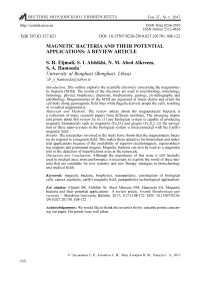Magnetic bacteria and their potential applications: a review article
Автор: Eljmali Sara Rajab, Alshikhi Salma Abrahem, Abed Alkreem Naeima Mohamed, Hamouda Samir Ahmed
Журнал: Инженерные технологии и системы @vestnik-mrsu
Рубрика: Медико-биологические науки
Статья в выпуске: 1, 2017 года.
Бесплатный доступ
Introduction. This outline explores the scientific discovery concerning the magnetotac-tic bacteria (MTB). The results of the discovery are used in microbiology, mineralogy, limnology, physics, biophysics, chemistry, biochemistry, geology, crystallography, and astrobiology. Magnetosomes of the MTB are organized in linear chains and orient the cell body along geomagnetic field lines while flagella actively propel the cells, resulting in so-called magnetotaxis. Materials and Methods. The review article about the magnetotactic bacteria is a collection of many research papers from different institutes. The emerging important points about this review lie in: (1) any biological system is capable of producing magnetic biomaterials such as magnetite (Fe3O4) and gregite (Fe3S4); (2) the navigation of these nano-crystals in the biological system is interconnected with the Earth's magnetic field. Results. The researchers involved in the study have shown that the magnetotactic bacteria do respond to a magnetic field. This makes them attractive for biomedical and industrial applications because of the availability of superior electromagnets, superconducting magnets and permanent magnet. Magnetic bacteria can also be used as a diagnostic tool in the detection of imperfections even at the nanoscale. Discussion and Conclusions. Although the importance of this issue is still limitedly used in medical area, more performance is necessary to explore the world of these bacteria that are candidate for new industry and new therapy strategies in biotechnology and medical fields.
Magnetic bacteria, biophysics, nanoparticles, construction of biological cells, cancer, medicine, earth''s magnetic field, nanoparticles technological applications
Короткий адрес: https://sciup.org/14720236
IDR: 14720236 | DOI: 10.15507/0236-2910.027.201701.108-122
Список литературы Magnetic bacteria and their potential applications: a review article
- Low E. Magnetic bacteria: A future in industry and medicine. Berkeley Scientific Journal. 2011; 14(2). Available from: http://escholarship.org/uc/item/1n3575xm
- Naresh M, Das S, Mishra P, Mittal A. The chemical formula of a magnetotactic bacterium. Biotechnology and Bioengineering. 2012; 5(109):1205. Available from: http://web.iitd.ac.in/~amittal/2012_Nar-esh_etal_Biotechnol_Bioeng.pdf
- Blakemore R. Magnetic bacteria. Science: New Series. 1975; 190(4212):377-379. Available from: http://www.calpoly.edu/~rfrankel/RPBScience75.pdf
- Blaney L. Magnetite (Fe3O4): Properties, synthesis, and applications. Lehigh review. 2007; 5(15):33-81. Available from: http://preserve.lehigh.edu/cas-lehighreview-vol-15/5
- Bazylinski DA, Frankel RB. Magnetosome formation in prokaryotes. Nature reviews. Microbiology. 2004; 2:217-230. Available from: http://www.calpoly.edu/~rfrankel/NatRevMicro.pdf
- Bazylinski DA. Small magnetism, big attraction: the magnetotactic bacteria. Available from: http://www.irm.umn.edu/SantaFe9/Bazylinski_SF9.pdf
- Kirschvink JL, Kobayashi-Kirschvink A, Diaz-Ricci JC, Kirschvink JS. Magnetite in human tissues: a mechanism for the biological effects of weak ELF magnetic fields. Bioelectromagnetics Supplement. 1992; 1:101-113. Available from: http://web.gps.caltech.edu/~jkirschvink/pdfs/KirschvinkBEMS92.pdf
- Devouard B, Posfai M, Hua X, Bazylinski DA, Frankel RB, Buseck PR. Magnetite from magnetotactic bacteria: Size distributions and twinning. American Mineralogist. 1998; 83(11-12, part 2):1387-1398. Available from: http://minsocam.org/MSA/ammin/toc/Articles_Free/1998/Devouard_p1387-1398_98.pdf
- Magnetism. California State University, Northridge, Magnetism MSE 630. 2008. Available from: http://www.freeppt.website/free-ppt/magnetism-ppt.html#
- Bazylinski DA, Frankel RB. Magnetotaxis in bacteria. Available from: http://www.calpoly. edu/~rfrankel/magbac101.html
- Dasdag S, Bektas H. Magnetotactic bacteria and their application in medicine. J. Phys. Chem. Biophys. 2014; 2(4): DOI: 10.4172/2161-0398.1000141
- Siores E, Lamb AS, Swallow LM. Bacterial magnetic particles for potential applications in na-noscale NDT&E. 4th International Conference on NDT, Hellenic Society for NDT. Chania, Crete, Greece. 2007. Available from: http://www.ndt.net/article/hsndt2007/files/Siores.pdf
- Blakemore RP, Blakemore NA, Frankel RB. Bacterial biomagnetism and geomagnetic field detection by organisms. Available from: http://andrewamarino.com/PDFs/MB/MB_Ch02.pdf
- Bolender R. Magnetosirillum magneticum genes MamB and MamM and a possible agent for bioremediation. Available from: http://digitalcommons.colby.edu/cgi/viewcontent.cgi?params=/context/clas/article/1813/type/native/&path_info=


